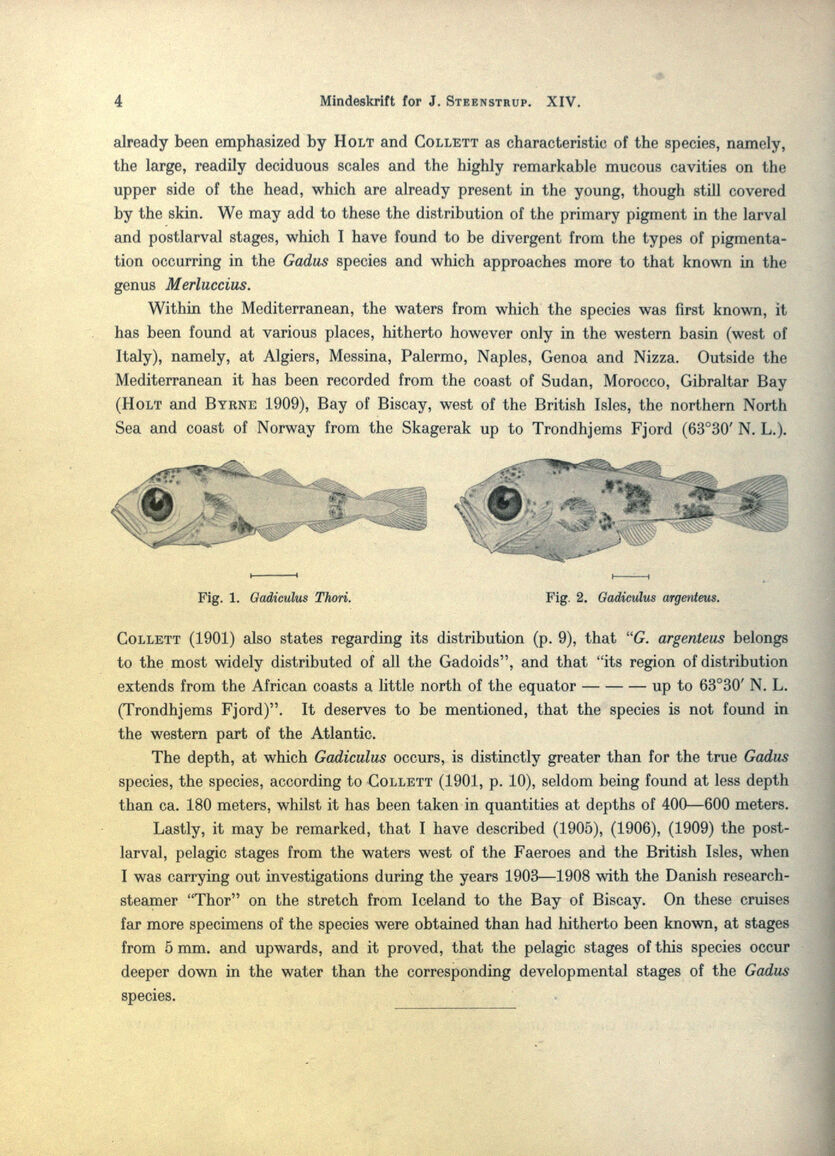
Full resolution (JPEG)
- On this page / på denna sida
- Gadiculus Argenteus and Gadiculus Thori

<< prev. page << föreg. sida << >> nästa sida >> next page >>
Below is the raw OCR text
from the above scanned image.
Do you see an error? Proofread the page now!
Här nedan syns maskintolkade texten från faksimilbilden ovan.
Ser du något fel? Korrekturläs sidan nu!
This page has been proofread at least once.
(diff)
(history)
Denna sida har korrekturlästs minst en gång.
(skillnad)
(historik)
already been emphasized by Holt and Collett as characteristic of the species, namely,
the large, readily deciduous scales and the highly remarkable mucous cavities on the
upper side of the head, which are already present in the young, though still covered
by the skin. We may add to these the distribution of the primary pigment in the larval
and postlarval stages, which I have found to be divergent from the types of
pigmentation occurring in the Gadus species and which approaches more to that known in the
genus Merluccius.
 | | Fig. 1. Gadiculus Thori. |
|  | | Fig. 2. Gadiculus argenteus. |
|
Within the Mediterranean, the waters from which the species was first known, it
has been found at various places, hitherto however only in the western basin (west of
Italy), namely, at Algiers, Messina, Palermo, Naples, Genoa and Nizza. Outside the
Mediterranean it has been recorded from the coast of Sudan, Morocco, Gibraltar Bay
(Holt and Byrne 1909), Bay of Biscay, west of the British Isles, the northern North
Sea and coast of Norway from the Skagerak up to Trondhjems Fjord (63°30’ N. L.).
Collett (1901) also states regarding its distribution (p. 9), that “G. argenteus belongs
to the most widely distributed of all the Gadoids”, and that “its region of distribution
extends from the African coasts a little north of the equator – – – up to 63°30’ N. L.
(Trondhjems Fjord)”. It deserves to be mentioned, that the species is not found in
the western part of the Atlantic.
The depth, at which Gadiculus occurs, is distinctly greater than for the true Gadus
species, the species, according to Collett (1901, p. 10), seldom being found at less depth
than ca. 180 meters, whilst it has been taken in quantities at depths of 400—600 meters.
Lastly, it may be remarked, that I have described (1905), (1906), (1909) the
postlarval, pelagic stages from the waters west of the Faeroes and the British Isles, when
I was carrying out investigations during the years 1903—1908 with the Danish
researchsteamer “Thor” on the stretch from Iceland to the Bay of Biscay. On these cruises
far more specimens of the species were obtained than had hitherto been known, at stages
from 5 mm. and upwards, and it proved, that the pelagic stages of this species occur
deeper down in the water than the corresponding developmental stages of the Gadus
species.
*
<< prev. page << föreg. sida << >> nästa sida >> next page >>
Project Runeberg, Sun Dec 10 11:29:37 2023
(aronsson)
(diff)
(history)
(download)
<< Previous
Next >>
https://runeberg.org/japetus100/xiv/0004.html



